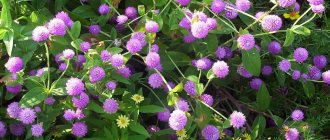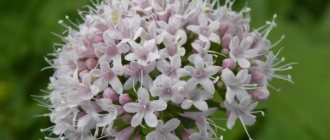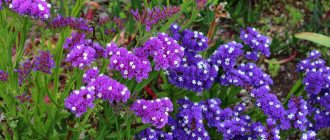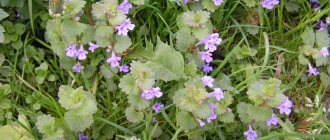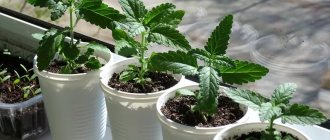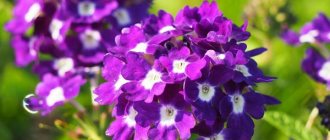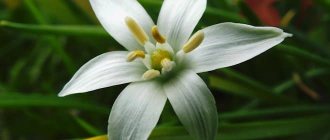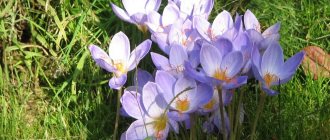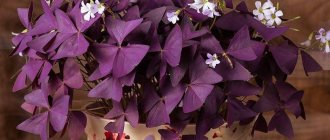Verbena is an unpretentious plant that is widespread in nature in America, Europe, Central Asia, and the Far East. The plant does not require special care and will take root well with a novice gardener. The flower is grown in open ground or in a pot. Propagation mainly occurs by seeds, but when storing an adult plant in the winter at home, you can propagate it by cuttings or dividing the rhizomes, however, this method is not welcomed by gardeners. Planting verbena seeds for seedlings is carried out according to special rules.
Characteristics of hybrid verbena
The size of the bushes can vary from 10 cm for dwarf varieties to 60-70 for tall ones. The stems are often erect, but creeping ones are also found. The shoots are tetrahedral, covered with short hairs.
The root system is quite branched, growing 15-25 cm in depth. The leaves are grouped below, at the base of the stem, their shape can be oblong, rounded at the end, triangular and heart-shaped. The color of the ground part has a deep emerald hue. Inflorescences - umbrellas consist of many small flowers of a wide variety of colors. It includes colors such as blue, purple, red, white, pink, cyan and peach. After flowering, a fruit is formed in the form of a nut or capsule.
Verbena - description, photos, varieties
Wild relatives of verbena are common in the New World, Central Asia, and the Far East. The plant is a perennial with a herbaceous or subshrub habit. Flower height is 20-100 cm. The culture has tetrahedral shoots of an erect or creeping type.
The surface of the stem and foliage is densely covered with transparent hairs. The leaves sit opposite, less often arranged in a regular order, in whorls. The shape of the plates is elongated-oval, with large notches running along the edge. There are individuals with whole or dissected plates.
Simple flowers with five petals reach a diameter of 15-20 mm. They grow together at the base, forming a shallow funnel. Each inflorescence bears from 30 to 50 buds, arranged in the form of a spike, brush or shield. The color of the corolla ranges from snow-white to dark blue. Hybrid individuals often have flowers with a white eye. The fruit of the plant is a nut that opens into 4 leaves.
Seed germination persists for 2-5 years. The peculiarity of seed reproduction is that the varietal characteristics of the parent pair are not transmitted to the descendants. The decorative period is from the beginning of summer until the onset of the first frost.
This is interesting! The buds emit a pleasant aroma, the crop is a productive honey plant. Fragrant essential oils are widely used in perfumery.
Although the genus Verbena has more than 100 species, only 5 of them are cultivated:
- Buenos Aires. The largest and most unpretentious representative of the genus, up to 120 cm tall. The lanceolate foliage has serrated edges and is located opposite. Tiny flowers with purple corollas are collected in dense umbrella-shaped inflorescences. Flowering is abundant and long lasting.
- Tough. Dense bushes with tetrahedral lodging shoots have a height of 30-60 cm. The stems branch intensively. The dense inflorescence of the corymbose type reaches a diameter of 3.5 cm and consists of tiny lilac flowers. The description of the plant indicates that the seed remains viable for up to 5 years.
- Canadian. A low-growing plant with fragile stems reaching a length of 15-20 cm. The foliage is oblong, deeply cut into lobes. Lilac white or pink corollas are collected in dense umbrellas. Blooms profusely in June until the first frost.
- Straight. The only crop of the genus that is a perennial species. She is able to survive wintering in central Russia. Plant height is 120-150 cm. Large sessile foliage reaches a length of 10 cm. The shape of the plates is oval with large teeth along the edges. Dark purple flowers are collected in dense spike-shaped inflorescences. Spike length up to 40 cm.
- Hybrid. Most often found in gardens, it has gained popularity due to its high decorative value. Forms dense cushions 20-50 cm high. The pointed lanceolate leaves are covered with colorless down, with jagged edges. The corolla of the flower consists of 5 petals, the palette is very diverse. Inflorescences are umbellate or corymbose type.
On a note! Among the garden hybrids (pictured below) there are large-flowered, compact, and ampelous forms. Each subspecies differs in the type of bush growth, structure, color and shape of inflorescences.
Photo of a hybrid variety
Next you will see a photo of a herbaceous plant for open ground, hybrid verbena:
Tips for caring for seedlings
Initially, the container with verbena is placed in a shaded area. With the appearance of the first green arrows, the pots are placed in a well-lit place. Germination time is approximate: 1-2 weeks.
The temperature should not exceed 20-21 degrees. The cover is removed daily for 5-10 minutes. As soon as the seedlings rise, the film is completely removed.
Watering
If you overdo it with watering, the plant will get a fungal disease - blackleg, which leads to the death of verbena.
Therefore, it is recommended to alternate spraying with watering: every 2 days. Water getting on the foliage and sprout is not desirable. Take settled water at room temperature.
Feeding
Young verbena needs feeding. This will have a beneficial effect on the development, growth, and formation of the plant’s immune system. Complex preparations in liquid form are chosen as fertilizers.
How and when to plant verbena seedlings
Picking is carried out with the appearance of the third true leaf. The procedure is carried out with extreme care so as not to damage the delicate root system. Verbena seedlings are transplanted immediately into separate containers.
Low-growing varieties do not require the formation of a lush bush. For large verbenas it is worth plucking.
Landing
Produced at the end of spring, when warm weather sets in. At this time, verbena seedlings are planted in a permanent plot. The place should be well lit throughout the day so that the light-loving beauty feels comfortable. You cannot plant a hybrid species in lowlands where moisture flows after rain or in wetlands. The plant is a drought-resistant species that does not tolerate constant dampness.
Read more about planting perennial verbena and growing the plant here.
Land preparation
The flower does not have any special requirements for the composition and reaction of the soil, but feels better on fertile loamy soil with a loose structure.
Heavy dense soil is mixed with sand and peat, and drainage from any stones is laid at the bottom of the planting hole. This will protect the roots from stagnation of water and rotting.
The soil must be mixed with humus and mineral fertilizers containing potassium and phosphorus. Bushes are planted in this nutrient mixture and the soil around is lightly compacted.
Use in garden design
Ampel verbena - growing in a pot, planting and care
Creeping, hanging varieties are mainly grown in pots and used to decorate balconies, loggias, and terraces. Upright bush varieties are planted in open ground.
Note! The best companions in flower beds for hybrid verbena are cineraria, pelargoniums, and petunias.
Pots with pelargoniums, verbenas and petunias
The planting site is chosen in bright sun. Only in this case will the plant be able to demonstrate the full potential of its inflorescences. In the shade the flowers become smaller.
Decorate the garden with verbena, choosing the optimal placement for each variety:
- dwarf flowers are planted along borders;
- compact medium-sized bushes are placed in arrays, as well as in flowerpots and flower pots;
- hanging varieties are planted in hanging balcony boxes and are also used in vertical gardening;
- All varieties need protection from the wind, because of which tall bushes can fall to the ground, and dwarf and ampelous ones lose their decorative effect.
Important! Cutting throughout the summer is carried out only from bushy tall verbenas, but regardless of the specific variety, the bouquets last in vases for only 2-3 days, and then they wither.
Care
It does not present any particular difficulties, since hybrid verbena is not a capricious plant at all.
Watering
Moderation and regularity are the basic principles of the event. Watering is carried out at the root during dry periods with an interval of at least 5 days. From mid-July the procedure can be further shortened.
Air humidity
The tropical guest tolerates dry air well for a long period, so there is no need to artificially increase the humidity. You should not spray during flowering, so as not to get unsightly brown specks on the delicate petals.
Top dressing
Organic matter must be added once, during planting. If verbena receives a lot of nitrogen compounds, it will begin to increase the green mass of leaves and stems. Having spent all the energy on this, it will no longer be able to bloom.
To stimulate active abundant flowering, it is necessary to periodically feed the plant with complexes of microelements.
Thermal mode
Hybrid verbena tolerates any heat well, but does not like cold weather.
Even a drop to 0° will be disastrous for her.
In hot weather, it is recommended to loosen the soil after watering to provide the roots with normal ventilation and avoid severe drying out and, as a result, compaction.
Preparing and sowing verbena seeds
Verbena can reproduce by self-sowing. Its seeds can be collected and used, but the qualities of the mother plant may not be preserved. It is best to buy verbena seeds from manufacturers, especially since every year breeders delight us with more and more new specimens that meet a variety of needs.
The packaging usually tells you how to properly grow a particular variety. Do not miss this important information, as some varieties do not require embedding in the ground, but, on the contrary, germinate well when exposed to light.
Verbena seeds are very small, so there is no point in sowing each one separately. For sowing, you need to prepare as many containers as there are varieties of this flower purchased, and sow each variety in a separate container. During the growing process, seedlings will need picking. That’s when a separate container for each plant will come in handy. Cups with a capacity of 150 - 200 ml will be quite enough.
Sowing process
After a series of preparatory activities. Verbena seeds must be sown. The soil must be processed and placed in a container in advance.
The soil is pre-moistened with settled water. Make a small ditch where you can sprinkle the seeds evenly. Cover with a layer of mixture (sand + soil) on top.
Cover with film to create a greenhouse. Send to a dark place for germination. The temperature regime is maintained at 23-25 degrees.
Growing from seeds
To get a flowering plant in summer, seeds are sown for seedlings no later than February. To do this, use small containers filled with loose substrate. You can buy ready-made universal soil or mix sand with peat and garden soil. The seeds are evenly placed on the surface and are not covered with soil on top. Instead, the boxes are covered with glass or plastic film. Sprouts appear within 13-15 days.
When the first pair of true leaves appears, the seedlings can be planted in separate cups or bowls.
Planting verbena in open ground
It can be planted with the onset of stable round-the-clock heat. Although verbena tolerates average daily temperature changes quite steadfastly, it does not tolerate severe spring frosts well. For most regions, suitable temperatures reach the end of May.
A place for planting verbena should be chosen that is sunny, but protected from strong winds. The soil in the selected area should be loose and moderately fertile.
Make the holes for planting no closer than 20 centimeters from one another. To avoid stagnation at the verbena roots, pour a little drainage material into the bottom of each hole. For this, it is best to use expanded clay. Over time, it will collapse in the earth and become part of it. Any other material (brick, ceramics, pebbles, etc.) will litter the ground. Add water to each well if necessary. It is better to plant verbena in holes with a clod of earth, carefully removing the plant from the containers along with it. After planting, lightly water the seedlings and, if necessary, add soil. To retain moisture, mulch the ground around the plants.
Growing from cuttings
An easy and affordable way to obtain planting material yourself. Cuttings are harvested in the fall, during the harvesting of faded plants. They need to be dug up along with a lump of soil and placed in a suitable container. For wintering, the bushes are sent to a fairly cool room with a temperature no higher than 7-9° . This could be a glazed balcony, cellar or basement.
For subsequent planting outside, the bushes are taken out in March. Their healthy apical shoots containing 5-6 axillary buds are cut off. Sections are disinfected with activated carbon powder or wood ash.
The finished cuttings are placed in a substrate of sand, peat and vermiculite, buried to the bottom leaf bud. To speed up root formation, containers are placed in a greenhouse or covered with plastic bottles. Roots begin to appear already in the second or third week.
Read more about growing verbena from seeds and propagating the flower by cuttings at home here.
How to grow verbena seedlings
Primrose from seeds - growing, tips and tricks
The step-by-step method consists of the following steps:
Hybrid verbena seedlings
- A mixture consisting of fertile soil and peat in equal proportions with acidity pH = 5.8-6.0 is loaded into containers for sowing seeds. For better breathability, you can add a little clean river sand.
- In order for the seeds to immediately begin to grow, they are pre-soaked for 2 hours and then stratified for 3-4 days in the refrigerator.
- The ideal temperature for seed germination is 22-24 °C. Shoots will appear on days 4-7. The seeds are not buried, but scattered over the surface of the soil.
- Seedlings are planted at the stage of one true leaf in individual pots or cups. This usually occurs five weeks after germination. At the stage of seed germination and before picking, it is recommended to keep the containers in greenhouse conditions, covered with a cap under which the air humidity is maintained at 100%. Seeds and young shoots themselves absorb water extremely slowly, but being in an over-watered state is fraught with the appearance of rot and mold. The cap allows you to solve this problem and spur plants to active growth and development.
- In the fifth week of development, the tops of the seedlings are pinched. In this way, plant tillering and the formation of a compact, symmetrical crown are stimulated.
- In the second half of May, in good weather, seedlings are planted in open ground, maintaining 20-25 cm between plants. The time is chosen so that at night the air temperature does not drop below 12 ° C.
Diseases
Hybrid verbena, like other varieties, is little susceptible to disease. But it can also be attacked by fungi and insects.
Powdery mildew
The fungus sets in high humidity amid warm weather. White blotches appear on the leaves, similar to spilled flour. Severe infestation causes their color to change to purple. Then the leaves fall off and the plant dies. The disease is treated with fungicides containing copper (Oxychom, Abiga-Pik, copper sulfate) and new combined systemic drugs (Vitaros, Ridomil Gold, Previkur).
Rotten
Verbena bushes can be attacked by almost any fungal rot. Among them are stem, black leg, root, gray. By cutting off all the affected parts in time and treating healthy tissues with fungicidal agents, you can save your flowers from the disease.
There are different types of verbena: finely cut, ampelous, medicinal, Buenos Aires. You can read about them on our website. We have also prepared information about the beneficial properties, uses and contraindications of medicinal verbena.
Growing perennial verbena
All botanical species of verbena discussed in the article are perennial plants, but only vervain is resistant to cold. The crop is primarily grown by seeds. Caring for seedlings is similar to the technology described for garden hybrids. The difference in cultivation lies only in the method of preparation for winter. Before the onset of frost, the shoots are removed and the rhizome is insulated with spruce branches. This material will protect the flower from frost and rodent attacks.
